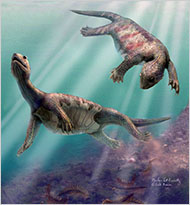 海龜的背甲要比腹甲長得晚
[ 2009-03-16 09:45 ]

我們都知道可愛的海龜背部有厚厚的甲,比腹甲要結實多了。但你知道嗎?在最初的進化過程中,腹甲的形成遠遠早于其背甲,當腹部的甲殼已經演化到與現代龜類相差無幾時,背部的甲殼才剛剛開始出現。最近在中國貴州出土的早期龜類化石就為我們揭開了這個謎底。
From the fossil record, you’d think that turtles burst upon the world with their shells intact. The oldest known species, a 210-million-year-old fossil from Germany, has a complete bottom shell, called a plastron, and a complete top shell, or carapace.
But fully shelled turtles didn’t just come out of left field. They evolved, and now a new fossil discovery suggests the route that shell evolution took.

In a report in Nature, Chun Li of the Chinese Academy of Sciences and colleagues describe a new ancestral turtle species based on fossils found in Guizhou Province in southwestern China. The species, which they named Odontochelys semistestacea, lived about 220 million years ago and was probably aquatic.
Like other early turtles, it has teeth rather than a sharp beak. But what really distinguishes it as representing an intermediate stage in turtle evolution is that it has only half a shell: while it has a full plastron, its carapace is incomplete. Instead, the turtle has bony extensions of the backbone and broader ribs.
One school of thought holds that ancient turtles had bony plates on their skin (similar to modern crocodiles) that eventually fused to form the shell.
But the researchers say their finding suggests that the shell evolved from skeletal changes. They note that in modern turtles, the carapace begins to form in the embryo through a similar extension of the backbone and widening of the ribs.
(來源:紐約時報網站 英語點津Jennifer編輯)
|